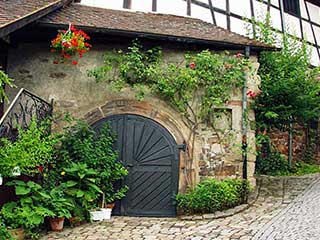Turmgasse mit Wolkenstein‘schen Kellern und altem Gefängnis
Der Turm des einst dort stehenden Stadttores „Storrentor“ gab der mittelalterlichen Gasse den Namen. Bis Ende des 18. Jahrhunderts als Kerker benutzt, wurde er wenig später wegen Einsturzgefahr abgebrochen.
1821 erfolgte der Neubau des Gefängnisses nur wenige Schritte nach dem Eingang zur Turmgasse, das seinen Zweck als Arrestlokal bis in die 1870er Jahre erfüllte
Zwei mit aufwändigen Beschlägen verzierte Rundbogenportale aus rotem Sandstein führen in die unterirdischen Keller des Wolkenstein’schen Wirtschaftsgebäudes. Beide Keller wurden 1605 erbaut. Der südliche Kellereingang trägt ein bis heute unbekanntes Wappen.
 Mobile
Mobile








